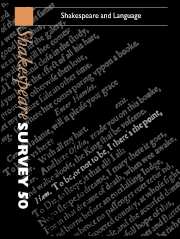Book contents
- Frontmatter
- Shakespeare’s Language and the Language of Shakespeare’s Time
- ‘I’ll plague thee for that word’: Language, Performance, and Communicable Disease
- The Language of the Spectator
- Marlowe’s Edward II: Penetrating Language in Shakespeare’s Richard II
- Hamlet’s Ear
- Secrecy and Gossip in Twelfth Night
- Shakespeare Rewriting Ovid: Olivia’s Interview with Viola and the Narcissus Myth
- ‘Voice Potential’: Language and Symbolic Capital in Othello
- Household Words: Macbeth and the Failure of Spectacle
- Erring and Straying Like Lost Sheep: The Winter’s Tale and The Comedy of Errors
- The ‘Shakespearian Gap’ in French
- Reading the Early Modern Text
- Shakespeare and the Metamorphosis of the Pentameter
- Rereading Illustrations of the English Stage
- Nietzsche’s Hamlet
- ‘Strange and woonderfull syghts’: The Tempest and the Discourses of Monstrosity
- Shakespeare Performances in England, 1996
- Professional Shakespeare Productions in the British Isles, January–December 1995
- 1 Critical Studies
- 2 Shakespeare’s Life, Times, and Stage
- 3 Editions and Textual Studies
- Books Received
- Index
‘Strange and woonderfull syghts’: The Tempest and the Discourses of Monstrosity
Published online by Cambridge University Press: 28 March 2007
- Frontmatter
- Shakespeare’s Language and the Language of Shakespeare’s Time
- ‘I’ll plague thee for that word’: Language, Performance, and Communicable Disease
- The Language of the Spectator
- Marlowe’s Edward II: Penetrating Language in Shakespeare’s Richard II
- Hamlet’s Ear
- Secrecy and Gossip in Twelfth Night
- Shakespeare Rewriting Ovid: Olivia’s Interview with Viola and the Narcissus Myth
- ‘Voice Potential’: Language and Symbolic Capital in Othello
- Household Words: Macbeth and the Failure of Spectacle
- Erring and Straying Like Lost Sheep: The Winter’s Tale and The Comedy of Errors
- The ‘Shakespearian Gap’ in French
- Reading the Early Modern Text
- Shakespeare and the Metamorphosis of the Pentameter
- Rereading Illustrations of the English Stage
- Nietzsche’s Hamlet
- ‘Strange and woonderfull syghts’: The Tempest and the Discourses of Monstrosity
- Shakespeare Performances in England, 1996
- Professional Shakespeare Productions in the British Isles, January–December 1995
- 1 Critical Studies
- 2 Shakespeare’s Life, Times, and Stage
- 3 Editions and Textual Studies
- Books Received
- Index
Summary
On the seventeenth of July, 1583, the town chronicler of Shrewsbury recorded in his diary an extraordinary event, an Elizabethan ‘freak show’:
cam to the towne . . . one Iohn Taylor . . . a marchant of loondoon and free of the coompany of fyshmoongers there who . . . brought . . . with hym strange and woonderfull syghts that ys to saye a dead childe in a coffyn which had ij heades and . . . ij bake boanes. More a lyve sheep beinge a tupp the which had . . . ij foondementes vnder hys tayle, also ij pyssells and ij paire of codds . . . and yf the partee which keapt hym wold aske hym and saye be thosse people welcoom he wold lyft vp hys foorefoote and Crye heighe, heighe, heighe . . . And also more a glasse artyfycially made beinge but ij candells therin and a chayne with ij faces or pycturs which wolld represent inwardly to the sight of the beholders soondrye candells, chaynes facys, Iuells and other things myraculously . . .
The chronicler's breathless narrative offers a powerful registration of some of the period's deepest fears and aspirations. In early modern England, 'monsters', defined in a 1634 translation of a medical treatise by Ambroise Paré as 'things . . . brought forth contrary to the common decree and order of nature', occupied vexed places in popular culture and scientific debate. Monstrous births were quickly versified in ballads, while fairs with monster booths drew holiday crowds. As monsters appealed to the amusement of the fairground populace, so did they tax the minds of the period's most established philosophers and authorities.
- Type
- Chapter
- Information
- Shakespeare Survey , pp. 187 - 200Publisher: Cambridge University PressPrint publication year: 1997
- 1
- Cited by

